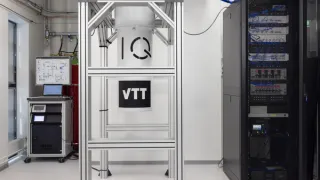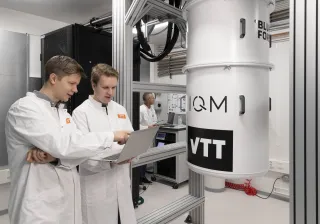VTT’s quantum computer HELMI (“Pearl”) has been connected with the pan-European supercomputer LUMI (“Snow”), hosted by CSC - IT Center for Science. The connection to Europe’s most powerful classical supercomputer enables the best possible use of the quantum computer’s computing power. This is the first time in Europe that this kind of hybrid service connecting a supercomputer and a general-purpose quantum computer is opened for researchers.
Quantum computers, while potentially extremely powerful at certain tasks, need supervision by traditional classical computers. Finland is one of the few countries worldwide that has connected a quantum computer and a supercomputer. Finland's first quantum computer, the 5-qubit HELMI hosted by VTT Technical Research Centre of Finland became operational in 2021. The LUMI supercomputer, hosted by CSC in Europe’s greenest HPC facility, also started its operations in 2021.
The successful connection of HELMI and LUMI paves the way to a future where quantum computers and traditional high-performance computers work together, solving those most difficult of problems that neither can solve alone. Integrating HELMI with LUMI enables hybrid computing projects and boosts the development of the required quantum algorithms and software. From here, an understanding about the potential of this technology for solving real-world use-cases will arise.
“VTT wants to do applied research using the quantum computer and learn more about these possibilities. We see great potential in quantum computing for accelerating innovation for the benefit of companies and the whole society. We will continue to build bigger and more powerful quantum computers, which will also become available for users through the same gateway”, says Pekka Pursula, Research Manager at VTT.
“LUMI is now the most powerful quantum-enabled supercomputing infrastructure in the world, in addition to being a leading platform for artificial intelligence. This means that we have all the drivers of the future of computing seamlessly integrated and ready to be utilized”, notes Pekka Manninen, Director of LUMI.

While supercomputers are immensely powerful by themselves, some types of problems can only be solved faster, more accurately, or using less energy when partially solved on quantum computers. These problems include developing new products and materials for example in the pharmaceutical, chemical, and battery industries. Quantum machine learning will take artificial intelligence to new heights. Thanks to the combined computing power, machine learning applications for generating novel molecular structures based on existing molecular data could be faster and more accurate, speeding up significantly the process of new material design. Optimisation of supply chains, travel routes, and portfolio management are also high on the list of future applications exhibiting so-called quantum advantage, where quantum-accelerated high-performance computing surpasses the capacity of classical supercomputers alone.
Some of the first concrete advantages can be expected in areas where high accuracy and quality of computational predictions are crucial, but the time for finding the answer is limited. One potential future application is short-term weather prediction, where it is important to quickly and accurately predict for example thunderstorms, hurricane paths and tsunami propagation. This is connected to real-time analysis of earth observation data from satellites. In the long term, high-quality image processing could, for example, detect a budding forest fire before it spreads uncontrollably. In the financial sector, higher accuracy in algorithmic trading naturally comes with instant reward.
Quantum algorithms at researchers’ fingertips
The connection was built in cooperation between VTT Technical Research Centre of Finland, CSC, and Aalto University, within the framework of the Finnish Quantum-Computing Infrastructure FiQCI. Now, through an open Call, pilot access to the infrastructure will be granted for users from Finnish universities and research organisations. This allows researchers to try out and experiment with quantum computing for various uses.
“Quantum computers are in many respects strange and unfamiliar, and it will be exciting to see how our customers end up using them. New technology tends to find uses in areas no-one even thought of before!”, comments Mikael Johansson, Quantum Strategist at CSC.
Real quantum computers behave rather unpredictably, it is in fact in their very nature. That is why completely new algorithms and approaches to problem solving need to be developed. First-hand availability of quantum computing gives users the opportunity to experience and adapt to the new computing paradigm. This is crucially important in order to prepare for the upcoming quantum revolution in scientific computing.
"We are creating the basis for future large-scale quantum computing infrastructure in Finland with this initiative. The first generation of quantum computers will be most valuable for training researchers and students in quantum algorithms and computing, and related technologies", says Tapio Ala-Nissilä, Professor of physics at Aalto.
After the academic pilot the aim is to open the connection for a wider audience. The newly established connection gives valuable insight on the possibilities of quantum computing, as well as practical know-how on how to utilise the new technology efficiently.
The Finnish Quantum-Computing Infrastructure, supported by the Academy of Finland and NextGenerationEU is a central part of the vibrant quantum technology ecosystem in Finland. FiQCI aims at providing true quantum-acceleration of research and development. The connection between HELMI and LUMI is the first major milestone on this road. A 20-qubit quantum computer is currently under development at VTT, with a 50-qubit upgrade planned for 2024. Beyond this point, the complexity of quantum computers surpasses the modelling capacity of even the largest supercomputers, marking the start of a new era of science. VTT, CSC, and Aalto University are also seeking global strategic partnerships to promptly usher in the quantum age.





